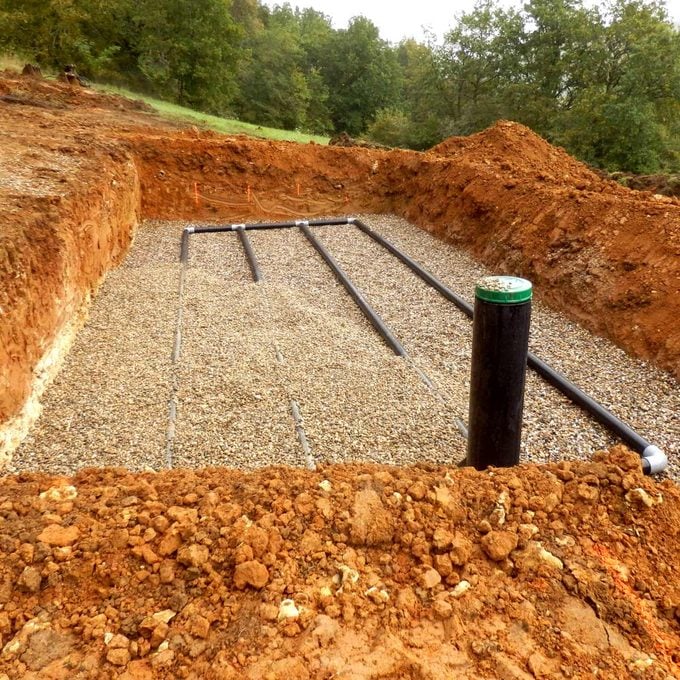5 Top Myths About Septic Systems
Updated: Mar. 08, 2024
There's a lot of misinformation out there about septic systems. Here's what you need to know.
Our editors and experts handpick every product we feature. We may earn a commission from your purchases.

If you’ve got a septic system at your house, then you’ve probably picked up some advice about managing that system that simply isn’t true. Here are the five top septic system myths dispelled.
On This Page
Septic Myth #1: Pump-Outs Are Unnecessary
The truth is, having a septic tank pumped every two or three years is the best and most economical way to keep your system working.
The no-pump myth comes from companies selling septic additives. The claim is that adding secret microbes and enzymes to the system can foster complete sewage digestion, eliminating the need to have the tank pumped every few years.
It’s an attractive idea, but risky and based mostly on hope. How do you know indigestible sludge isn’t building up to dangerous levels in your tank as you opt for no pump-outs, year after year?
And besides, is there really an additive that can cause the complete digestion of hair, lint, fingernail clippings, fat and all the other indigestible materials that build up on the floor of a septic tank?
Pump-outs are the only way to ensure that damaging levels of indigestible solids are not rising to the level of the tank outlet and flowing out to clog your system’s leaching pipes.
Septic Myth #2: It Doesn’t Matter What You Put Down the Drain
It actually matters a great deal what you put into a septic system.
While it’s true that septics can be quite reliable and easygoing, putting poisons such as drain cleaner, disinfectants and solvents down your drain will diminish or eliminate the microbes that digest sewage, increasing the risk of system failure.
Even just one cup of household bleach, for example, can kill all beneficial microbes in a 1,000-gal. septic tank for a time. These microbes will eventually re-establish themselves, but not until some sewage goes undigested.
Another big no-no? Coffee grounds. They don’t readily digest and can get into your leaching bed, where they can contribute to system failure.
There are just two things that can safely be put into a septic system: wastewater and sewage. Get to know how septic tanks work.
Septic Myth #3: Flushing a Dead Mouse Down the Toilet Helps a Septic System
Some say that a dead mouse contains unique microbes that improve septic system performance. This is false. Every time you flush a toilet for the usual reasons, you’re introducing a fresh infusion of beneficial microbes.
While the old mouse trick seems wise and reassuring, a few ounces of dead animal isn’t providing anything essential that’s not already coming from other sources.
Go ahead and flush dead mice down the toilet if you want, but you’re not doing your septic system any favors. In fact, septic additives in general (even “natural” ones) are questionable, at best. (See Myth #1.)
Septic Myth #4: You Can’t Expect a Septic System to Last More Than 20 Years
Truth be told, many septic systems keep working perfectly after two decades of service. I know because I’ve met many people with 20-plus-year-old systems. The oldest I’ve seen so far is 49 years old, and still working perfectly.
At the other end of the spectrum, I’ve seen septic systems fail after just five years of use. Septic system working life has much more to do with management than it does with some arbitrary lifespan expectation.
To up your system’s chances of a long working life, have the tank pumped every two or three years, avoid putting poisons down the drain and keep your leaching bed mowed and free of anything other than grass. You can also try these new septic tank treatment pods.
Septic Myth #5: Clogged Septic Systems Must Be Replaced
The fact is, many clogged septic systems can be restored with maintenance, so replacement isn’t always necessary.
Three of the most common causes of clogs — indigestible sewage solids entering the leaching bed, slimy biomat growths blocking the holes in the perforated leaching pipes and tree roots physically clogging the leaching pipes — can usually be solved without replacing any part of the system.
Instead, look into a process called “jetting,” which involves installing access ports on the ends of the leaching pipes so you can give them an internal pressure-wash to clear them out. There’s no reason that a septic system can’t function indefinitely if the leaching pipes and bed are jetted internally with high-pressure water from time to time.
Other than having the septic tank pumped every few years, jetting is the simplest and most effective option for restoring a failed or failing system. I’ve seen a septic system clogged so badly that there were 12 inches of raw sewage sitting above the top of the tank — yet this same system functioned perfectly for years after jetting the leaching pipes.
And speaking of septic systems, here are the 20 dirtiest jobs in the world.
